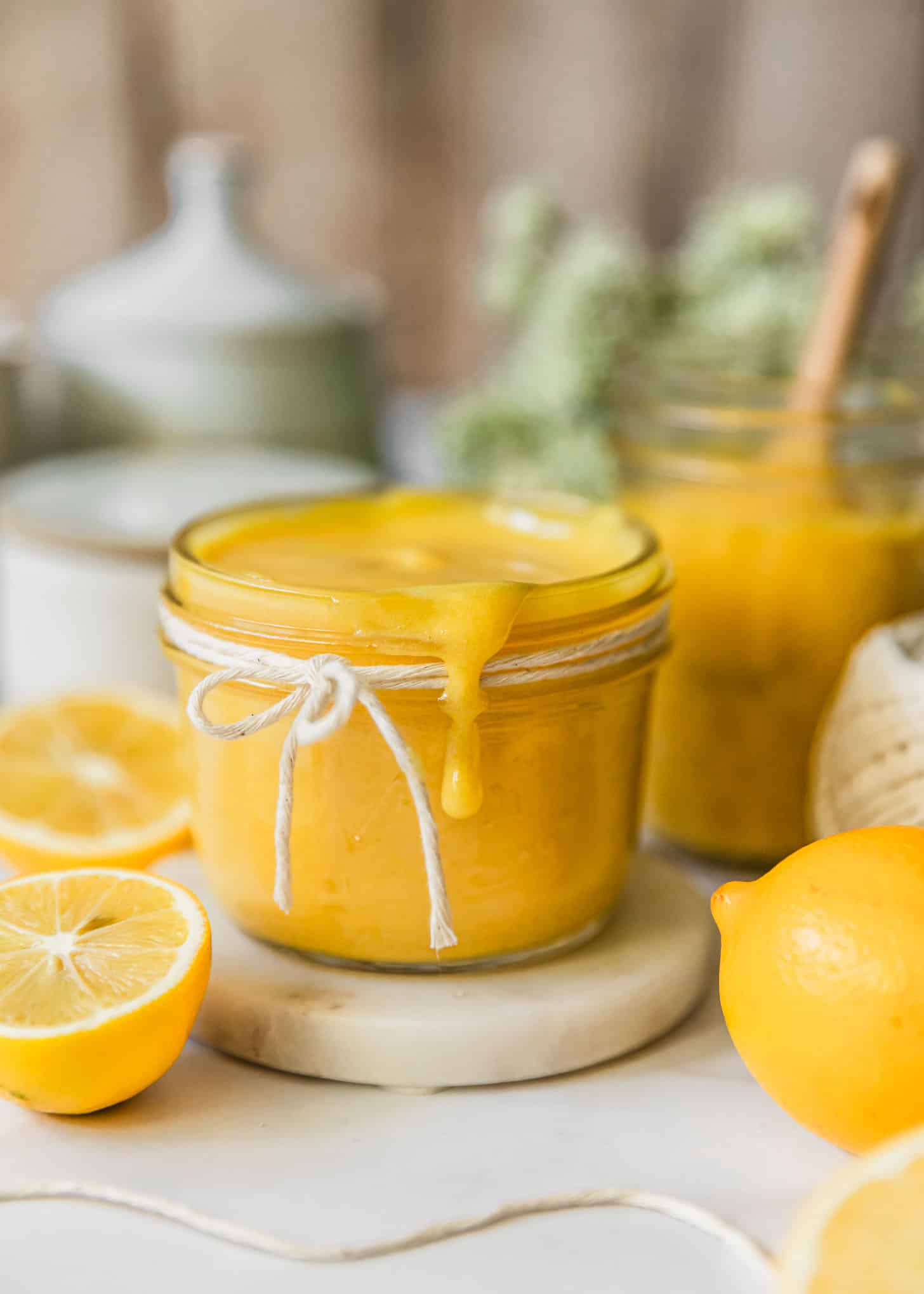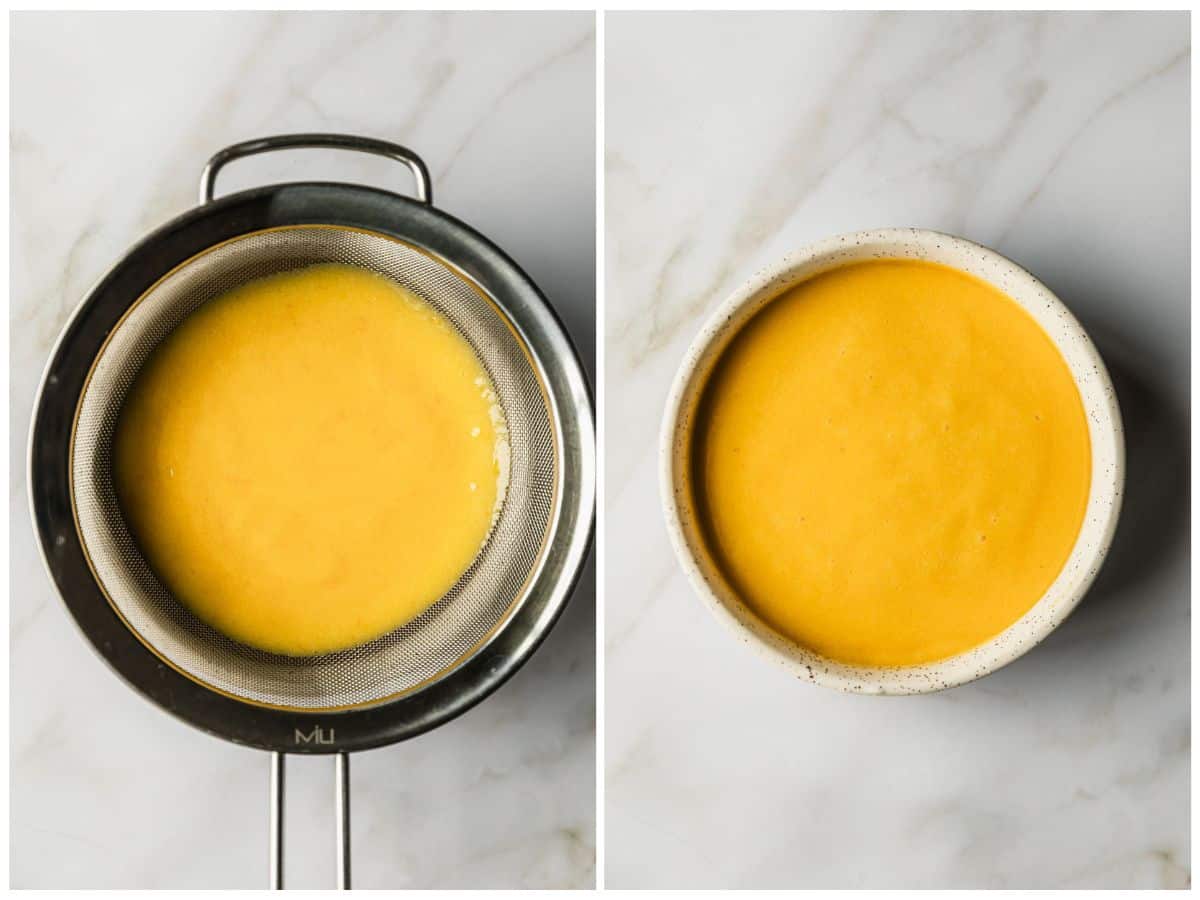Easy Meyer Lemon Curd
This post might have affiliate links. For full details please see my disclosure policy.
This homemade Meyer lemon curd is beyond easy to make from scratch! With just a handful of ingredients, it comes together quickly and goes on everything from cookies and cakes to scones and pancakes. It’s perfectly sweet, tart, buttery, and so delicious!

The other day I was *blessed* to come across a bag of Meyer lemons. I don’t think it’s a coincidence that bright, gorgeous citrus pops up right in the middle of winter when we all need a little sunshine. Shoutout to nature.
So I don’t think it needs to be said that I grabbed a couple of bags. And what’s a girl to do when she’s in possession of armfuls of Meyer lemons? Well, make curd.
Lemon curd is one of those staple recipes I learned how to make when I was in pastry school. But with Meyer lemons? Beyond. This curd belongs on everything from cookies to scones.
If you’re not sure where to start, no worries my friends. Bake it up in my best ever lemon curd cookies or dollop it over my creamy mini lemon cheesecakes. This stuff is like liquid gold.
Only 5 ingredients

All you need to make this recipe is five ingredients (ok six if you count salt). Make sure you have granulated sugar, Meyer lemons (zest and juice!), egg yolks, Morton’s Kosher salt, unsalted butter, and vanilla bean paste or extract. If Meyer lemons aren’t in season, you can use regular. Just keep in mind, the curd will be a bit more tart!
The easiest way to make curd

For this recipe, it’s important to use a pot that’s non-reactive like stainless steel or ceramic. You will also want to use a non-metal whisk. I like rubber whisks! If you use metal, it could negatively react with the acid in the lemon juice which will make the curd taste bitter and metallic.

For lemon curd that’s nice and thick, make sure it reaches 170°F (77°C) and coats the back of a spoon. If it still hasn’t thickened, whisk 1 teaspoon of cornstarch with 1 Tablespoon of water. Add it to the lemon curd, and stir for a few minutes until it reaches your desired texture.

Make-ahead & refrigerate
Spoon the lemon curd into a jar. Press a small piece of plastic wrap against the surface to keep a film from forming. Then, seal the jar with a lid and refrigerate it for up to 1 week.
Freezing tips
To freeze the lemon curd, spoon it into an airtight container. Cover the container and freeze it for up to 1 year. When you’re ready to use the curd, just pop it in the refrigerator to defrost overnight. Give it a stir and it should be good to go!
If you have a lot of Meyer lemons to use up, you can make large batches of curd to use throughout the year! Either freeze the lemon curd or place it in jars and gift it to friends.

If you make this recipe, I would love it if you left a star rating and review! I read every single comment and love hearing what you think about my recipes. Thank you for supporting Sunday Table!

Easy Meyer Lemon Curd
Ingredients
- 150 grams sugar (3/4 cup)
- 8 grams Meyer lemon zest, about 4 lemons (2 Tablespoons)
- 6 egg yolks
- 120 milliliters fresh lemon juice, about 6 lemons (1/2 cup)
- Pinch of Kosher salt
- 85 grams cold unsalted butter, cut into cubes (6 Tablespoons)
- 1 teaspoon vanilla bean paste or vanilla extract
Equipment
- Non-reactive saucepan (ceramic or stainless steel)
Instructions
- Pour the sugar and lemon zest into a non-reactive saucepan. Using clean hands, rub the sugar and lemon zest together until it's fragrant and the lemon zest has released its oils, about 1-2 minutes.
- Add the egg yolks to the lemon sugar. Using a rubber whisk, whisk the egg yolks and sugar together until the mixture is thickened and pale yellow, about 2-3 minutes. Whisk in the lemon juice until the mixture is smooth. Then, stir in the salt.
- Cook the lemon curd over medium-low heat, whisking constantly, until the mixture thickens, reaches 170°F (77°C), and coats the back of a wooden spoon. Don't let the curd come to a boil!
- Remove the pot from the heat and add the cold cubes of butter. Whisk until the butter is completely melted. Then, stir in the vanilla bean paste.
- Strain the lemon curd through a fine-mesh sieve to remove any lumps or lemon zest. Let the curd cool for a few minutes. Then, pour the lemon curd into a jar and press a small piece of plastic wrap against the top to keep a film from forming. Seal the jar and refrigerate the curd for up to 1 week.





Make it every year and give away most. Thanks for easy recipe and tips.
Thanks, Barbara! So glad you found this post helpful. 🙂
Delicious and easy to make. I prefer to skip the straining and leave the zest in the curd. It’s delicious 😋. Thank you for sharing this recipe 🤗
Thank you so much, Barbara! I’m so glad you loved this recipe. 🙂 I also like leaving the zest in the curd for extra texture!